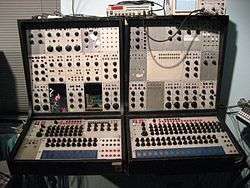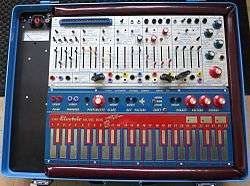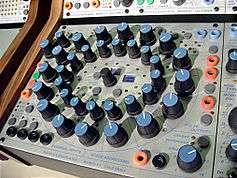Don Buchla
Donald Buchla (April 17, 1937 – September 14, 2016) was an American pioneer in the field of sound synthesis. Buchla popularized the "West Coast" style of synthesis. He was co-inventor of the voltage controlled modular synthesizer along with Robert Moog, the two working independently in the early 1960s.[1][2]
Don Buchla | |
|---|---|
 Don Buchla and Buchla 200e (2006 NAMM Show) | |
| Background information | |
| Birth name | Donald Buchla |
| Born | April 17, 1937 South Gate, California |
| Died | September 14, 2016 (aged 79) Berkeley, California |
| Occupation(s) | Electronic musical instrumental inventor |
Biography
Buchla was born in South Gate, California on April 17, 1937,[3] and grew up in California and New Jersey.[4][5] He studied physics, physiology, and music at UC Berkeley, graduating in 1959 as a physics major.[4]
Buchla formed his electronic music equipment company, Buchla and Associates, in 1962 in Berkeley, California.[6] He was commissioned by composers Morton Subotnick and Ramon Sender, both of the San Francisco Tape Music Center, to create an electronic instrument for live performance.[4] Buchla began designing his first modules for the Tape Music Center in 1963.
With partial funding from a $500[7] Rockefeller Foundation grant made to the Tape Music Center, Buchla assembled his modules into the Buchla Modular Electronic Music System (later known as the Series 100) in 1965, which he began selling commercially in 1966.[1] Buchla's synthesizers experimented in control interfaces, such as touch-sensitive plates. In 1969 the Series 100 was briefly sold to CBS Musical Instruments, who soon after dropped the line, not seeing the synthesizer market as a profitable area.[8]
1970 saw the release of the Buchla 200 series Electric Music Box,[3] which was manufactured until 1985. Buchla created the Buchla Series 500, the first digitally controlled analog synthesizer, in 1971.[3]
Shortly after, the Buchla Series 300 was released, which combined the Series 200 with microprocessors. The Music Easel, a small, portable, all-in-one synthesizer was released in 1972. The Buchla 400, with a video display, was released in 1982. In 1987, Buchla released the fully MIDI enabled Buchla 700.[9]

Beginning in the 1990s, Buchla began designing alternative MIDI controllers, such as the Thunder, Lightning, and Marimba Lumina. With the recent resurgence of interest in analog synthesizers Buchla has released a revamped 200 series called the 200e.
In 2005, NIME-05 (5th International Conference on New Interfaces for Musical Expression), in Vancouver, Canada, featured a keynote lecture by Don Buchla. There was also a sizable exhibition of many of the instruments he and his team have created over the years.[10]
In 2012, Buchla's intellectual property was acquired by an Australian holding company, Audio Supermarket, which started a new brand called Buchla Electronic Musical Instruments (BEMI). Mr. Buchla was retained as Chief Technology Officer.
In 2015, it was reported[11] that Don Buchla had taken the owners of BEMI to court, citing health problems due in part to unpaid consulting fees and asserting a claim to his original intellectual property. The lawsuit alleged breach of contract and "bad-faith conduct" on the part of BEMI's owners and sought $500,000 in compensation.[12]
Legal documents[13] filed with the state of California indicate that the court ordered the case to be settled by arbitration in July 2015. In August 2016, the court dismissed the case in light of the fact that the parties had reached an out-of-court settlement.
As of 2018, a new company called Buchla U.S.A. has been created to carry on Don's legacy and continue producing his 200e modular synthesizer system[14], with certain individuals involved in engineering and manufacturing remaining involved.
Death
Buchla died at the age of 79 on September 14, 2016 of complications from cancer in Berkeley, California.[15][16][17]
Personal life
He was survived by his wife[18], a son, Ezra Buchla who is a musician, [17] daughters Jeannine Serbanich and Erin Buchla, and two grandchildren.
Products
- Products designs by Don Buchla

.jpg) Analog sequencers (bottom) on Buchla 100 (1963/1966)
Analog sequencers (bottom) on Buchla 100 (1963/1966) Buchla Music Easel (ca.1973) [20]
Buchla Music Easel (ca.1973) [20] Model 250e Multiple Arbitrary Function Generator module
Model 250e Multiple Arbitrary Function Generator module.jpg) Model 260e Duophonic Pitch Class Generator module
Model 260e Duophonic Pitch Class Generator module Oberheim OB-Mx (1994) designed by Don Buchla
Oberheim OB-Mx (1994) designed by Don Buchla
_%40_nordcafe%2C_Teknisca_Museet.jpg) Buchla 200 (1970–1985)
Buchla 200 (1970–1985) Buchla 200e (2004–)
Buchla 200e (2004–)
References
- "Remembering Synthesizer Innovator Don Buchla (1937-2016)". Bob Moog Foundation. 2016.
- "Don Buchla - Passing The Acid Test". Red Bull Music Academy. 2007.
- Frank Hoffmann (November 12, 2004). Encyclopedia of Recorded Sound. Routledge. pp. 311–. ISBN 1-135-94949-2.
- Pareles, Jon. "Don Buchla, Electronic Music Maverick, Dies at 79". New York Times. Retrieved September 18, 2016.
- Laurent de Wilde (March 23, 2016). Les fous du son. Grasset. pp. 186–. ISBN 978-2-246-85928-4.
- Jones, Kevin L. "Don Buchla, Influential Synthesizer Designer, Dead at 79". KQED. Retrieved September 18, 2016.
- https://www.youtube.com/watch?v=b1moEseg14c
- Mark Vail. "Buchla Series 200". Keyboard Magazine (Nov. 2005). Archived from the original on 2006-05-10.
- "Buchla Electronic Musical Instruments - Historical Overview". Buchla and Associates. Archived from the original on 2006-01-15.
- "May 26-28 2005 - Vancouver, Canada". nime.org. Retrieved February 11, 2018.
- "Don Buchla is taking the owners of his brand to court". 25 March 2015.
- "Buchla v. Buchla".
- "Buchla v. Buchla Electronic Musical Instrument, LLC et al". Justia Dockets & Filings.
- http://cdm.link/2018/01/buchla-synth-legacy-secured-new-leadership-returning-engineers/
- "Don Buchla, Inventor, Composer and Electronic Music Maverick, Dies at 79". The New York Times. September 19, 2016.
- "Modular synthesizer pioneer Don Buchla has died". factmag.com. Retrieved February 11, 2018.
- Dayal, Geeta (16 September 2016). "Don Buchla, modular synthesizer pioneer, dies aged 79". The Guardian.
- "Film about music pioneer Don Buchla in the works". 9 April 2013.
- "Buchla Ken Kesey". MATRIXSYNTH.
- "The Music Easel". Buchla & Associates. Archived from the original on 2010-07-31.
- "Collection Checklist". Cantos Music Foundation. Archived from the original on 2010-08-12.
- "Introducing the Moog PianoBar". Moog Music. Archived from the original on 2009-10-02.
External links
| Wikimedia Commons has media related to |
- Buchla and Associates
- Audities Foundation Buchla instrument collection
- "Oral History: Don Buchla explains pieces of his life story and career." January 16, 2011. NAMM Oral History Library
- Instrumental Instruments: Buchla